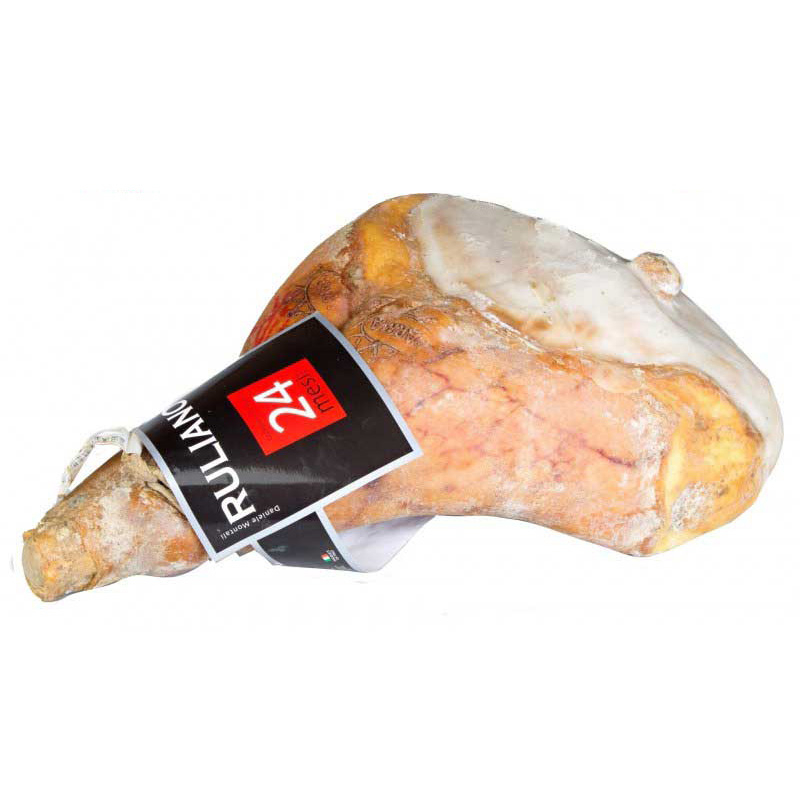
Description
The Ruliano 24-month Prosciutto di Parma with bone is produced by the Ruliano company. The processing is ancient and has been passed down for 2 generations, with father Giuseppe passing on the art of refining to his son Daniele. For the production of this prosciutto, the hams are carefully selected, only the best will be part of the 24-month line. No preservatives and additives are used in Parma ham. The territory is one of the keys to the success of Parma: the hills of Parma are characterized by a mild climate, with dry and delicate air: in this context, the natural aging of Ruliano Prosciutto di Parma takes place, giving the unmistakable sweetness and delicacy to this prized cured meat loved throughout Italy and abroad. Nutritional label for 100 g of Prosciutto di Parma Energy value (calories) 269 kcal Proteins 25.9 g Carbohydrates 0.3 g sugars -- g Fats 18.3 g saturated 6.12 g monounsaturated 8.7 g polyunsaturated 2.62 g cholesterol 81 mg Dietary fiber -- g Sodium 1760 mg. CERTIFIED BY CONTROL BODY AUTHORIZED BY MIPAAF Pairings: Excellent consumed pure, accompanied by fried gno and simply with bread. Excellent pairing with Lambrusco or Bonarda. Storage: Store in a cool, dry place Processing: For the production of Parma ham, there is a strict regulation imposed by the Consortium of producing companies in full respect of tradition. The exclusivity of this cured meat begins with the selection of pigs that must be of a single breed, the Large White Landrace and Duroc, and fed with quality foods including whey derived from Parmigiano Reggiano. The hams are cooled in special cells for 24 hours and then trimmed, that is, parts of fat and rind are removed to give a rounded shape to the ham. This shape, in addition to being characteristic of the ham, is also useful for the subsequent salting. Salting is a delicate and complex phase that consists of covering the ham with salt. This operation is carried out by skilled hands and the difficulty is to use the correct salt (moist on the rind parts and dry on the lean parts) when the ham is at a precise and uniform temperature. Subsequently, the hams are placed in a cold room for 15-18 days, then left to rest in a new refrigerated cell for the same number of days once cleaned and re-salted. At the end of this period, the residual salt is removed and the hams are left to rest. After more than 60 days, the hams are rinsed with warm water to remove impurities and residues and are left to dry in the sun on cool and windy days. They are then hung on "scalere", a sort of wardrobe in well-ventilated premises to allow natural, gradual, and constant drying. The next phase is called "sugnatura" and consists of covering the muscular part with lard, a mixture of fat and ground pepper to soften the more superficial layers. From the seventh month, the Prosciutto can be placed in cellars, establishments intended for aging that play a decisive role in attributing the typical aromas and flavors to the ham. Only after a year and several inspections by the Parma Quality Institute Inspectors, can Parma ham be branded and destined for sale. Aging: 22
Ingredients
Nutritional Analysis
Attention
Macronutrients (100 gr)
| Energy (kcal) | 269 |
| Carbohydrates (g) | 0.3 |
| Fat (g) | 18.3 |
| of which Saturates (g) | 6.12 |
| Protein (g) | 25.9 |
| Sale (g) | 1.76 |
Nutritional Analysis
- Proteins25.9g·58%
- Carbohydrates0.3g·1%
- Fats18.3g·41%
- Fibers0g·0%
